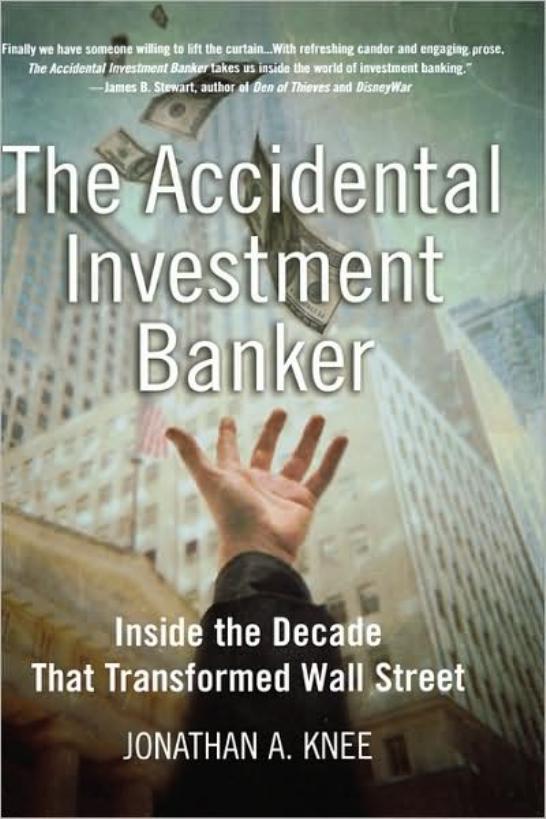The Accidental Investment Banker: Inside the Decade that Transformed Wall Street by Jonathan A. Knee

Author:Jonathan A. Knee
Language: eng
Format: mobi, pdf
·9·
CRACKS IN THE FAÇADE
Although the beginning of the Internet era is usually dated from the 1995 IPO of Netscape, it did not begin to deeply infect the rest of the investment banking world until 1999. To be sure, we were all aware of it: after Netscape, Yahoo had gone public in April 1996, Amazon.com in May 1997 and eBay in September 1998. And one could hardly miss the Morgan Stanley technology group’s seemingly endless self-promotion in trade magazines. Many groused that the group paid a senior banker with no client responsibility to manage public relations. Such observations were of course typical of the kind of snide comments you might expect in a decentralized organization where petty intergroup jealousies abound. It was in late 1998 that the floodgates opened. Early-stage technology
companies—companies whose lack of historic operating results would have been an absolute bar to public flotation only a few years earlier—were now coming to the market in droves. These newly liquid entities, flush with cash from their overvalued stock offerings, fueled an unprecedented merger boom.
The impact of this technology binge on the overall investment banking business—both in terms of the sheer magnitude and the changing composition of the industry’s business mix—would first be realized in 1999. The number of U.S. technology IPOs would approach 400, over double the previous year and a rate of more than one a day. In M&A circles, the 1980s had been remembered as the modern boom era. But in 1999, Goldman Sachs, Morgan Stanley, and Merrill Lynch each worked on over $1 trillion of M&A deals, more than the total volume of mergers consummated in any year during the 1980s. Indeed, the combined transaction volume represented by these three firms in just 1999 exceeded that of all firms combined for the entire decade of the 1980s.1
At this point, the technology boom could no longer be smugly dismissed by bankers in other sectors. This was not simply a function of the fact that the technology banking business was growing so much faster than other sectors. The problem stemmed from the fact that the valuations in the Internet world were not only astronomically higher than in any other industry, but appeared to be based on entirely new methods of calculation. Although analogous to or modeled on more conventional methods, the precise contours of these mysterious valuation techniques were known only to a close-knit group of technology bankers fully immersed in these dark arts.
At bottom, traditional valuations are based on some assessment of current earnings or cash flow and future prospects. Current earnings are, by definition, more certain than future, so methods grounded in the former are less speculative than those grounded in the latter. For this reason, the least precise of traditional valuation methods is the “discounted cash flow” or DCF, which estimates the present value of cash flows projected five or even ten years out. DCF valuations can swing wildly based on relatively minor changes in assumptions on growth and interest rates. Typically, the majority of the
Download
The Accidental Investment Banker: Inside the Decade that Transformed Wall Street by Jonathan A. Knee.pdf
This site does not store any files on its server. We only index and link to content provided by other sites. Please contact the content providers to delete copyright contents if any and email us, we'll remove relevant links or contents immediately.
International Integration of the Brazilian Economy by Elias C. Grivoyannis(90806)
The Radium Girls by Kate Moore(11921)
Turbulence by E. J. Noyes(7935)
Nudge - Improving Decisions about Health, Wealth, and Happiness by Thaler Sunstein(7615)
The Black Swan by Nassim Nicholas Taleb(7010)
Rich Dad Poor Dad by Robert T. Kiyosaki(6399)
Pioneering Portfolio Management by David F. Swensen(6226)
Man-made Catastrophes and Risk Information Concealment by Dmitry Chernov & Didier Sornette(5921)
Zero to One by Peter Thiel(5685)
Secrecy World by Jake Bernstein(4643)
Millionaire: The Philanderer, Gambler, and Duelist Who Invented Modern Finance by Janet Gleeson(4374)
The Age of Surveillance Capitalism by Shoshana Zuboff(4209)
Skin in the Game by Nassim Nicholas Taleb(4161)
Bullshit Jobs by David Graeber(4094)
The Money Culture by Michael Lewis(4076)
Skin in the Game: Hidden Asymmetries in Daily Life by Nassim Nicholas Taleb(3929)
The Dhandho Investor by Mohnish Pabrai(3698)
The Wisdom of Finance by Mihir Desai(3650)
Blockchain Basics by Daniel Drescher(3506)
